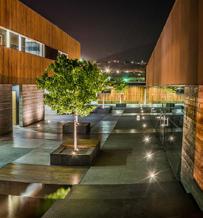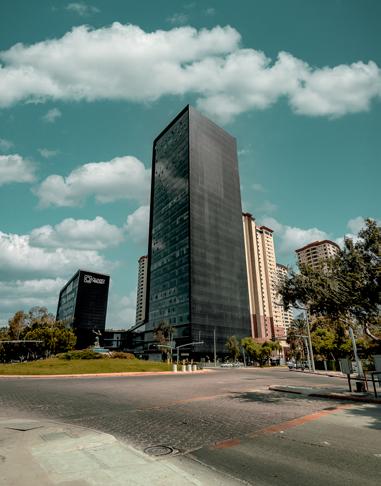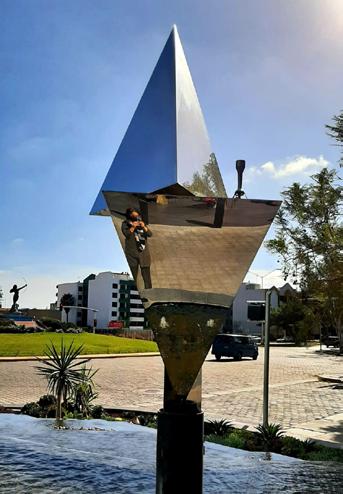
10 minute read
CREATIVE TIJUANA (ENG)
THE CREATIVE ECONOMY
A NEW FRONTIER FOR THE DEVELOPMENT OF TIJUANA.
Advertisement
BY DR. FLAVIO OLIVIERI
It is time to promote a creative economy for Tijuana and Baja California in general, as we have reached a tipping point in our history with the recent designation together with San Diego as World Design Capital for the year 2024 by the World Design Organization (WDC 2024 – WDO®). This designation is a world-renowned recognition of great prestige that is only awarded every 2 years to cities or regions that are distinguished for their creative capacity and the use of design-thinking principals in solving their challenges and maximizing their opportunities for economic, social, and environmental development.
This is the first time that the award is given to a binational region. This unique proposition was one of the main reasons why the selection committee chose the San Diego – Tijuana bid. They highlighted our cross-border collaboration and the focus on people centered solutions as a unique feature globally. More information about the bid cand be found at www.home2024.com. Other cities that have previously ben designated design capital include Seul (South Corea), Torino (Italy), Helsinki (Finland), Mexico City and for 2022 Valencia (Spain). During the tow years of the designation a series of international events will be held to promote the region globally, showcasing our best practices in sustainable urban development and on building institutions that improve quality of life through innovation. The eyes of the world will be focused on the San Diego-Tijuana region, which offers Tijuana a great opportunity to demonstrate its capabilities in the creative economy.
So, why is it important to promote the creative economy of Tijuana? Globally efforts to develop the creative industries of countries or regions have proven to bring significant benefits to their population. Also known as the Orange Economy, we refer to the creative economy as economic activities related to the creation, production, distribution and dispersion of products and services derived from original content, ideas, and knowledge. The majority of these tangible or intangible creations can be protected for their authoring rights, certifying its originality, and generating value to their consumers. The creative economy can be seen as a complex system of value creation derived from the creativity and talent of people. These activities not only include culture and art, but a broader set of activities such as publishing, multimedia, audio-visual, phonography, cinema, design, and crafts, as well as more current applications such as videogames, software and scientific research and development. Technological developments have merged different disciplines in new creative expressions such as virtual reality for training, music therapy or gastro-tourism.

Some of the most successful cases globally in promoting their creative economy is South Corea. In particular their K-Pop industry that generates over five billion dollars annually according to the online magazine Seulspace. In the European Union there are regional strategies to promote the creative industries that have been very beneficial, specially for less populated urban centers. The creative economy represents 3.3% of the total EU GDP, generating over 7 million jobs, in addition to the over 6 million of jobs related to the luxury and fashion industries, representing another 3% of the EU GDP, according to the EU Cluster Observatory report on creative industries from 2013.
In Latin America we also find several initiatives to foster the creative economy. The Interamerican Development Bank, the UN Development Program, and UNESCO since 2013 have published several reports and public policy recommendations to develop the Orange Economy in Latin America. These efforts have resulted in the creation of clusters in Montevideo and Sao Paulo. In Colombia the current federal government has establish a national strategy to promote the Orange Economy. In Mexico since 2010 the State Government of Jalisco initiated the Guadalajara Creative Digital City based on an urban redevelopment project of the historic downtown district, developing co-working facilities, workshops and digital labs for small companies and independent professionals of digital technologies including film, 3D animation, software, and other audio-visual disciplines.
For Baja California and Tijuana in particular the creative economy represents a great opportunity to generate links with the highest concentration of creative industries in the world, just next door in California. Our geographic proximity enables us to establish face-to-face connections and personal relationships with the value networks of creative industries that generate revenues of over $650 billion dollars annually ($414 billion in value added) and over 2.7 million jobs, that represents 15% of total employment statewide. Los Angeles County concentrates about 30% of the Creative Economy and 38% of the employment, with salaries averaging $68,000 dollars annually, which is higher than the State´s average income. The main subsector is Entertainment and Digital Media with 70% of the permanent employment and over 80% of the contract employment, with salaries averaging at $130,000 dollars annually, making it the highest paying subsector. The second subsector is fashion, even though it has declined in recent years, represents 11% of employment for the creative economy of California, with salaries averaging at $56,000 dollars annually, way below the State average, except for those focused on design with incomes of $91,000. (Source: 2020 Otis Report on the Creative Economy – Becon Economics).

In the case of San Diego, our next-door neighbor, the creative economy has a significant impact, as well as challenges for growth, and where Tijuana could play a complementary alternative. There are over 7,400 firms related to the creative economy that generate about 4.5% of the GDP worth over $11 billion dollars and about 5% of total employment in the County, with 51,200 direct jobs and 56,460 indirect jobs representing about 7% of the total creative economy employment of the State. The main subsector is Digital Media, wit average salaries of $107,000 dollars annually, a total production of $2.4 billion. The growth of this subsector is driven mainly by emergent media such as software, video games and other interactive media (virtual or augmented reality).
The main challenges for San Diegos creative economy growth and sustainability include access to talent, high real-estate cost for workshops and performing centers, lack of regional branding and primarily the high cost of housing. Creative Economy firms have increased difficulties in finding talent as they compete with other sectors like Biotech and Information Technology, that have more capacity to pay higher salaries. Additionally, the revitalization of urban center spaces has increased the rent for spaces suitable for workshops, studios, exhibition and performing. Another difficulty for San Diego is consolidating its own brand, differentiated from LA´s strong positioning. The main inhibitor is the cost of living for professionals of the creative economy, considering that a significant portion are independent contractors, about 13,000 that earn on average lower wages. Some of the challenges for the creative economy of San Diego and Southern California in general, represent an opportunity for Tijuana and Baja California. In the last decades the economy of Tijuana has been transitioning from one based on low-cost export manufacturing to one based on services. According to a study conducted by CETYS University on regional systems for creative production, Dr. Jorge Francisco Sanchez, and Dr. Ingrid Juri, highlight that from 2008 to 2013 the industrial sector decreased is GDP by 0.1%, while the retail and services sectors increased 1.3 and 4.3%, in particular higher value-added subsectors such as education, cultural leisure, sports and recreation, and mass media. Additionally, the researchers highlight those creative industries concentrate 5.4% of total employment with over 42,000 hobs. The creative industries generate 5.8% of total value added that represents about $350 million dollars annually and $150 million dollars in wages (Data from INEGI 2014). Finally, the study highlights that Tijuana has the highest concentration of activities related to the creative economy, with higher employment rates than the rest of the State in 13 of 24 subsectors.
The geographic proximity of Tijuana with San Diego and Southern California, offers a competitive advantage to integrate with value chains of the creative economy in the region, as it has been in the manufacturing and tourism sectors for decades. Recently we have seen examples of such linkages in the film and digital media (software) production subsectors, where Tijuana based firms provide contracting services for companies in California. Although these cases are emergent and few apart and haven’t reached systemic linkages or critical mass integration. To achieve this level of collaboration, Baja California needs a Statewide strategy and public policy that focuses on the creative economy, that creates the incentives, infrastructure and promotional programs needed. A good start is the recent announcement of the incoming State Government administration about creating for the first time a department of creative industries within the Secretary of the Economy. Also we start to see more solid community initiatives to foster the creative economy, such as the efforts of Tijuana Innovadora that announced a partnership with CIPE (Center for International Private Enterprise), to promote the participation of youth in creative economy organizations and start-ups.

A proven strategy in Europe and the U.S., and somewhat in Mexico, has been the formation of specialized industry “Clusters”. In the case of the creative economy, it has been demonstrated that geographic proximity and urban concentration increase competitiveness by stimulating collaboration, the exchange of knowledge and ideas, converging of disciplines and innovation of new media, as well as attracting talent and investment. As a result, the promotion of “Creative Districts” has resulted in higher collaboration, generating more face-to-face spaces. These districts can be from one neighborhood to a metropolitan region, with a unique identity and innovative urban strategies of mixed land use, smart growth, and place making focused on mass transit mobility and pedestrian environments that foster diverse social activities (“live, work, play”).
We can now imagine a creative district that is binational, that stimulates the integration of cross-border value chains in the creative economy. This is what is being proposed by the Border Fusion initiative (bfusion.org), to create a binational creative district in the surrounding areas of the San Ysidro port of entry community, creating spaces for face-to-face collaboration, with a focus on smart growth urban planning, place making, pedestrian and mass transit mobility, with its unique identity and global branding. In this micro economic zone, we already see significant investment in the Medical Services subsector and other professional high value services, such as education and software development. In addition to creative districts a prioritization strategy will be require focusing resources in high-potential subsectors such as emergent digital media (videogames, digital media – special effects, postproduction, world building), music, fashion, literature, and visual arts. Considering that the videogame industry alone produced in 2020 over $170 billion dollars, according to the portal Zippia.com.

Memorial for Moy Abadi
Sculpture by Jack Winer
Beyond the positive economic impact, the creative industries generate favorable externalities for economic development. Due to their creative nature new processes are developed that strengthen the innovation culture for experimentation and problem solving. These activities translate to social innovation and entrepreneurship, strengthening our regional competitiveness, the agglomeration of talent and the attraction of tourism, as well as creating identity, belonging, and community collective action. Finally this reflects in the public space, in the physical urban environment, with smart urban planning and stronger social networks.
Lets take advantage of the moment as a city and State, lets take advantage of the convergence of recent milestones such as the World Design Capital designation (WDC2024), the new department of creative industries in the State Government incoming administration and the initiatives of Border Fusion and Tiuana Innovadora. Let’s leverage this momentum to promote a creative economy strategy and strengthen our linkages with the value chains of the creative economy of California. Without a doubt this represents a new frontier for economic development for Creative Tijuana.

Flavio Olivieri









